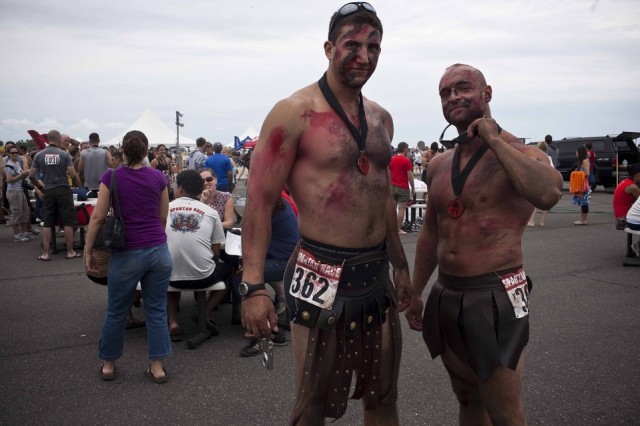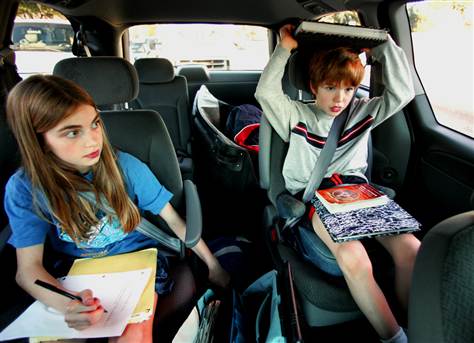So it’s been roughly a year since my last post to this blog. The good news is that I didn’t meet some untimely death doing the Spartan Race that I wrote about last year (although I did manage to tear my lateral meniscus through a total bonehead maneuver that was in no way the fault of the race itself). But I can’t credit a torn meniscus for my radio silence. Rather, over the course of last winter and spring, I came to a realization that after three years of being home with the kids, doing gobs of volunteer work, and working on this blog, I was ready for something different. I felt that I’d come to another junction in my life and I had to make a choice
One path – one that I seriously considered last year – involved taking my writing about faith ‘to the next level’. Mostly I considered going back to school – either Divinity School or graduate school for Religious Studies/Sociology of Religion. I am one of those weird people who actually love school, and getting a PhD had long been on my bucket list (OK, maybe a bit below snorkeling with whale sharks, but it was on there). But to be frank, the logistical realities of this path overwhelmed me. Not only would it mean a financial hit from the tuition for any program, but most likely I would need to hire some help for my three kids on those days when I had class and they had to be at three after-school activities at once (not to mention getting help with the hound dog who needs an hour-long walk in the woods every day). So I was facing a double negative financial hit for multiple years, after which I’d come out with a degree that would generate lower potential earnings than I could make with my MBA. This same MBA had taught me that the ROI on such an investment was not attractive.
But more fundamentally – I realized that as much as I love studying and writing about religion, philosophy and other ‘big issues’, I wasn’t sure that doing that all day every day would actually be fulfilling. I really like to feel like I am having a direct, concrete impact on the world. I try to live my life based on the Hillel’s golden rule:
If I am not for myself, who will be for me
If I am only for myself, what am I
And if not now, when?
If I don’t feel like I am actively helping others, I am not happy. I am not a saint – at all – but I just like to be doing things where I can see the results of my work. In the case of writing about religion – the fact is that none of these issues can be resolved. By definition. I can spend the rest of my life struggling with all of these questions, and provoking others to think about these questions, and it will never end. I realized that for me, I needed to pursue work that had more tangible end results. I admire and value those who write and provoke others to think, or provide inspiration through their beautiful words. And if I have done that in the past, or can at times do that again through this blog, that’s great. But I needed to do something more with my life.
So, I started my own business, leveraging all of the marketing and technology skills I had developed during my previous work experience, plus some additional ones I’d picked up during my years ‘not working’ (during which time I obviously learned how to create and manage a blog, plus through my volunteer work built several websites, learned how to manage a church database system, etc). Since last spring, along with my business partner (one of my closest friends from business school) we have been using our skills to help non-profit organizations. We’ve built websites. We’ve configured, implemented and cleaned up donor database systems. We’ve conducted market research to help an organization refine the direction of one of its programs. And I’m absolutely loving it. I’m learning new things all the time, because technology constantly evolves. Each project has a clear deliverable, and at the end I have the satisfaction of seeing something I have clearly achieved. he results of my work are clear-cut and tangible. That’s something that is much harder to achieve when writing about religion.
I also have had one other important realization: life is too short to read super-intense, intellectually taxing books all the time. I have been slumming with fun stuff like Game of Thrones and Shogun, and having a blast. But I haven’t had as much to write about philosophically because I honestly have just been too busy to have deep thoughts.
Oh, and I’ve gotten completely hooked on training for and running obstacle course races (that’s me jumping over the fire in the pic below).
After recovering from knee surgery last summer, I went on to run another obstacle course race last fall and came in 4th for my age group. This year I’m planning to run a Spartan Trifecta (three obstacle course races in one year, each of increasing length and difficulty). Running and training has become a true source of joy for me – the repetition of running, or doing push ups or burpees – provides a weird form of spiritual peace (plus burning huge calories allows me to indulge my insatiable sweet tooth).
So – that’s my situation. I am not closing up this blog. I hope that when inspiration takes me, or I get a moment to read something relevant, I will stop in and write a post. But I will not be posting regularly. Thanks to all of you who have followed this blog in the past, and provided constructive feedback. I wish you well and will write when I can!















